Weeds In Real Life, Delightful Additions To Miniature Gardens
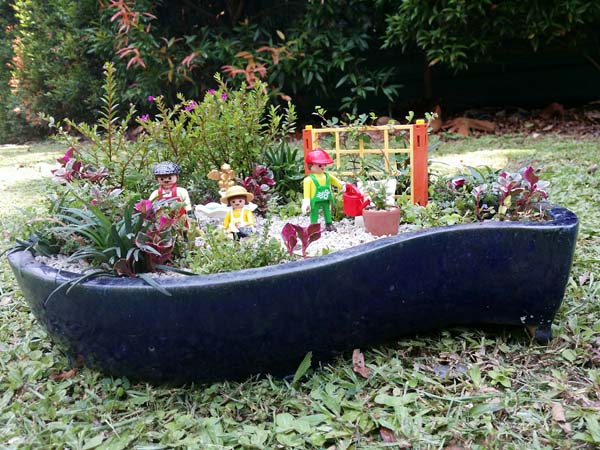
Those of us who garden would probably find weeds a nuisance. They grow and spread in our flowerbeds, flower pots and lawn, and we spend a lot of effort and resources to eradicate them from our gardens.
But did you know that some weeds have an ecological value, serving as food for the biodiversity around us? Also, some of these weeds are relatively small and they often go unnoticed if we do not look hard enough. Due to their small stature, some weeds can be used to make miniature gardens.
In a miniature setting, plants with features like leaves, flowers and fruits, are required to be of the right size so that the finished garden is the right scale and proportionate to one another. This creates a more realistic-looking landscape. Depending on the size of miniaturisation, the minute details of a plant need to be examined closely. When in doubt, make a measurement, so as to ensure that the plants chosen are scaled appropriately for use in your work.
Unlike house plants that are sold in pots, weeds need to be harvested from open spaces. Before harvesting any plants, make it a point to ask for permission before doing so.
During harvesting, the root systems of plants are often damaged. Depending on the extent of root damage during harvesting, plants might wilt if they are planted directly into the miniature garden. This will affect the aesthetic of the final product. It is recommended that you pot the plants up and let them re-establish before using them in your miniature garden construction.
Below is a selection of six weed plants that you can consider using in your miniature gardens.
Artillery Plant
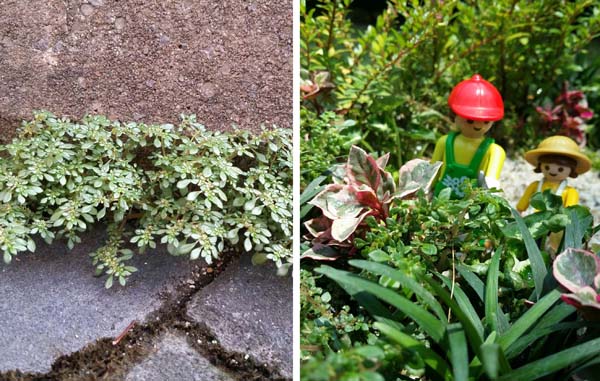
The Artillery Plant in its natural state (left) usually grows in a sunny or semi-shaded location, often between narrow spaces with very little growing media. The plant with its small leaves is used as a ‘filler’ to soften the look of broad-leaved plants in the miniature display (right).
Botanical name - Pilea microphylla Family – Urticaceae
This is a fairly common plant that can be found growing from crevices in footpaths and the base of walls. It is a largely herbaceous plant that prefers filtered light. Its roots should be kept moist at all times but not wet. The plant takes on a moulding growth habit.
With its tiny leaves, it can be used to mimic a small foliage shrub in a miniature setting.
Lesser Clover-leaved Desmodium
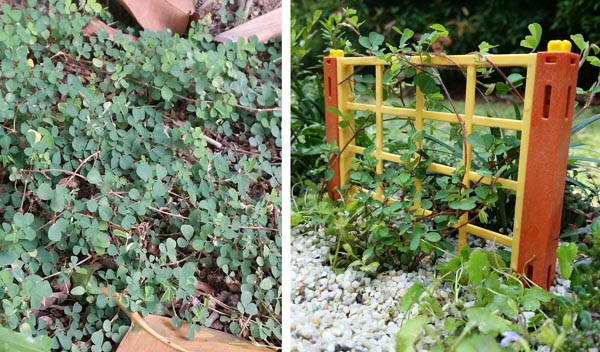
The Lesser Clover-leaved Desmodium (left) can grow as a groundcover plant on a bare patch of land. For the miniature display (right), it has been trained to look like a climber.
Botanical name - Desmodium triflorum Family - Fabaceae
The Lesser Clover-leaved Desmodium is a common weed found in turf areas. It grows as a trailing plant and formsa dense carpet amongst the turf grass. This plant can be found growing under direct or filtered sunlight conditions. The plant has thin wiry stems with leaves that are trifoliated. Each leaflet is shaped like an inverse triangle with blunt edges. When night falls or under low light conditions, the plant responds by folding up its leaves, a habit that is commonly seen in plants belonging to the bean family.
In a miniature setting, the Lesser Clover-leaved Desmodium can be trained up a vertical trellis to make it look like a climber or cascading creeper that is allowed to drape over a planter box.
Asiatic Pennywort
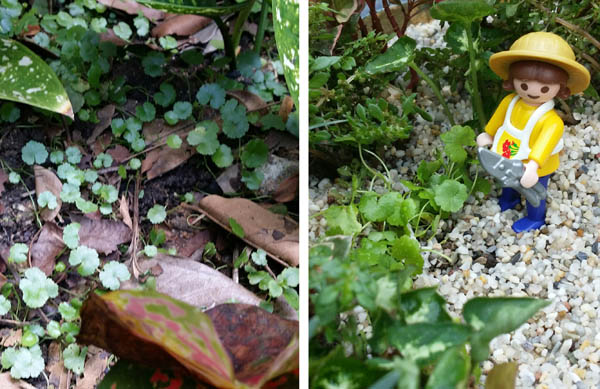
In a natural setting (left), the Asiatic Pennywort has colonised the spaces between plants in an ornamental flower bed. It has been arranged to look like a trailing ground-cover plant in the miniature display (right)
Botanical name - Hydrocotyle sibthorpioides Family - Araliaceae
The Asiatic Pennywort is a semi-aquatic, trailing herbaceous plant that can sometimes be found growing in bright, moist to wet areas where it escaped from cultivation. It can be found growing underwater and is sometimes offered as an aquascaping plant for sale in aquarium shops. It features thin, wiry stems which root at the nodes and small, almost round leaves that have attractive scalloped leaf margins.
In a miniature setting, the Asiatic Pennywort is best used as a creeper to form a ground cover where the stems can be in contact with moist soil. Depending on the scale of your miniature garden, this plant can be used to simulate a lotus plant in a pond.
Malayan Eyebright
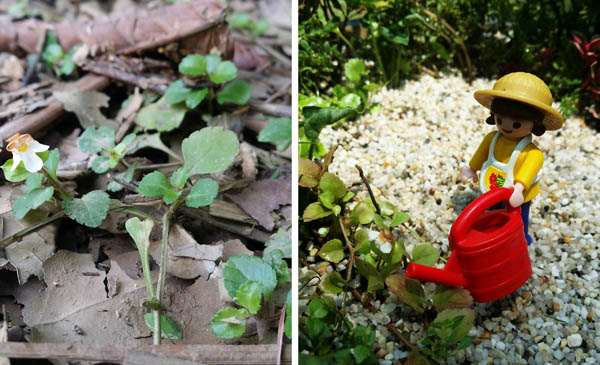
The Malayan Eyebright is shown growing as a ground-cover plant on a bare patch under the shade of a tree (left), and in the miniature display (right).
Botanical name - Legazpia polygonoides Family - Linderniaceae
The Malayan Eyebright plant grows as a herbaceous creeper in garden beds and lawns. This plant can be found in semi-shaded and sunny areas with moist soil conditions. Under intense light, its leaves take on a reddish hue. It is a plant with small heart-shaped leaves and long trailing stems that root at the nodes. It produces numerous white flowers with a reddish throat.
In a miniature setting, the Malayan Eyebright can be trained up a vertical trellis to make it look like a climber or cascading creeper that is allowed to drape over a planter box.
Brittle False Pimpernel
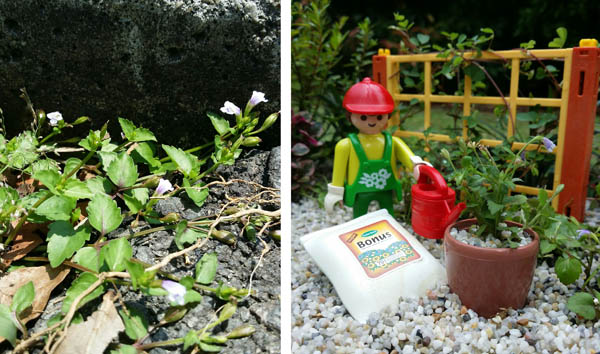
In its natural state, the Brittle False Pimpernel can sometimes be found growing from crevices (left), but in the miniature display (right), it is used as a potted plant because of the plant’s small size when young. The Brittle False Pimpernel has small pretty flowers.
Botanical name - Lindernia crustacea Family - Linderniaceae
Like many other weeds, the Brittle False Pimpernel grows as a herbaceous creeper in garden beds and lawns. This plant can be found grown both under semi-shaded and sunny areas. It is a plant with small heart-shaped leaves and long trailing stems that root at the nodes. It produces numerous delightful, light purplish flowers.
In a miniature setting, the Brittle False Pimpernel can be displayed as a flowering shrub.
Thyme-leaf Spurge
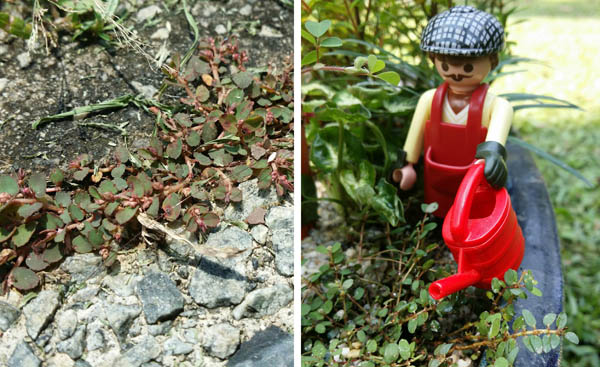
The Thyme-leaf Spurge can be commonly found growing between concrete slabs (left), but is used as a sprawling shrub in the miniature display (right).
Botanical name - Chamaesyce thymifolia Family - Euphorbiaceae
The Thyme-leaf Spurge is another weed that can be seen growing from crevices. It is often seen growing in sunny and dry conditions and adopts a creeping growth habit. The plant features red, wiry stems with small, oval, purplish green leaves that are arranged on both sides of the stem.
In a miniature setting, it can be used as a groundcover plant. This plant likes drier conditions. Hence, keep the soil mix just barely moist.
Text and photos by Dr Wilson Wong


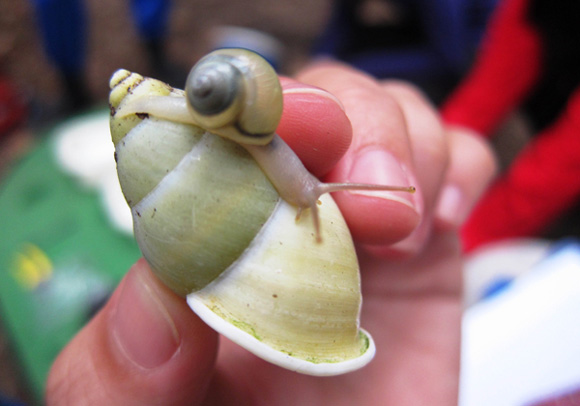

Have views or comments on this article? Let us know via this form. If you would like to give us feedback on any other areas relating to our parks and gardens, please submit via https://www.nparks.gov.sg/feedback